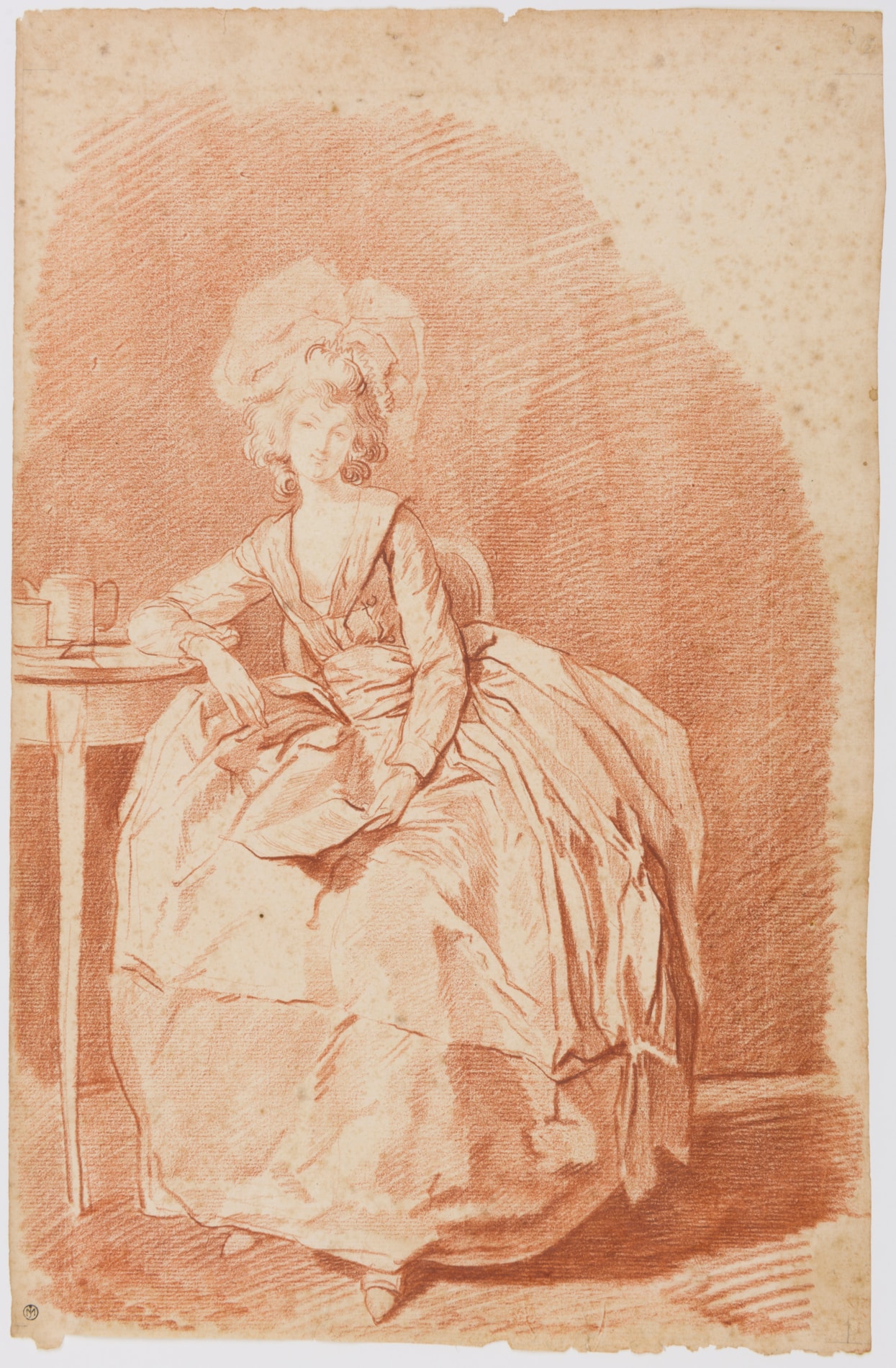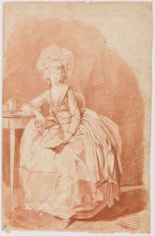Louis-Roland TRINQUESSE
(Paris (?) 1745 - Paris (?) 1800)
A Young Woman Seated, Holding a Letter
Sold
Red chalk on buff paper.
353 x 229 mm. (13 7/8 x 9 in.
353 x 229 mm. (13 7/8 x 9 in.
A large number of Trinquesse’s drawings of women depict one of three sitters, who have been identified as Marianne Franmery, Louise Charlotte Marini and Louise-Elisabeth Bain, although almost nothing else is known about them. These women, whose facial features seem to correspond to the artist’s ideal of beauty, appears, identified by name, in three profile portrait drawings in a medallion format by Trinquesse. Each of these circular drawings, including the portrait of Marianne Franmery, are signed and dated 1780.
These models are depicted in Trinquesse’s drawings standing full length in an interior, sitting at a writing table or reclining on a sofa, seemingly deep in thought or looking back coquettishly at the viewer. As been noted of the artist’s drawings of women, ‘His assured handling of red chalk, at once hard and lively, is easily recognizable…Executed in a fluid yet highly controlled manner, they are stylish and elegant, leading some to suggest that the drawings may have been intended as fashion plates.’ Furthermore, another recent scholar has been pointed that the artist’s highly finished drawings of this type ‘often seem to be related to figures de mode(or fashion plates), for which the models adapt their poses to show off their costumes.’
The model for the present sheet has been identified as Marianne Franmery, who appears in perhaps more drawings by Trinquesse than any other identifiable sitter. As Jean Cailleux has described the present sheet, ‘Again, in my opinion, she [ie. Marianne Franmery] reappears in two drawings in the Masson Collection. The first, entitled La Lettre, shows her seated beside a small table on which are a teapot and a cup. Seated on a Louis XV chair she faces the spectator and wears a large bonnet with ribbons à l’alsacienne; she holds a letter in her left hand.’ Franmery reappears in several other finished drawings in red chalk by Trinquesse, including a sheet formerly in the Goncourt collection and now in the National Gallery of Canada in Ottawa and another in the Ashmolean Museum in Oxford, as well as others in private collections, such as a drawing of Two Women in an Interior in a Parisian private collection.
As Cara Denison has written of Trinquesse’s drawings of this type, the artist ‘was not interested in the facial expression or in the individualization of his sitters; his preoccupation was the rendering of costume in every elegant detail (the flounced skirts and bodices as well as the fancy bonnets and plumed hats). Executed in the red chalk medium and in a fluent drawing style these drawings are small masterpieces in the genre of costume design.’
Jean Masson (1856-1933) gave much of his extensive collection of ornamental drawings and prints to the Ecole des Beaux-Arts in Paris. His superb collection of 18th century French master drawings, however, was dispersed at several auctions in Paris between 1923 and 1927. The present sheet was included in the first of these sales and fetched the sum of 4,300 francs. The drawing later entered the collection of the antiquaireJacques Bacri (1911-1965) of the Parisian firm Bacri Frères.
These models are depicted in Trinquesse’s drawings standing full length in an interior, sitting at a writing table or reclining on a sofa, seemingly deep in thought or looking back coquettishly at the viewer. As been noted of the artist’s drawings of women, ‘His assured handling of red chalk, at once hard and lively, is easily recognizable…Executed in a fluid yet highly controlled manner, they are stylish and elegant, leading some to suggest that the drawings may have been intended as fashion plates.’ Furthermore, another recent scholar has been pointed that the artist’s highly finished drawings of this type ‘often seem to be related to figures de mode(or fashion plates), for which the models adapt their poses to show off their costumes.’
The model for the present sheet has been identified as Marianne Franmery, who appears in perhaps more drawings by Trinquesse than any other identifiable sitter. As Jean Cailleux has described the present sheet, ‘Again, in my opinion, she [ie. Marianne Franmery] reappears in two drawings in the Masson Collection. The first, entitled La Lettre, shows her seated beside a small table on which are a teapot and a cup. Seated on a Louis XV chair she faces the spectator and wears a large bonnet with ribbons à l’alsacienne; she holds a letter in her left hand.’ Franmery reappears in several other finished drawings in red chalk by Trinquesse, including a sheet formerly in the Goncourt collection and now in the National Gallery of Canada in Ottawa and another in the Ashmolean Museum in Oxford, as well as others in private collections, such as a drawing of Two Women in an Interior in a Parisian private collection.
As Cara Denison has written of Trinquesse’s drawings of this type, the artist ‘was not interested in the facial expression or in the individualization of his sitters; his preoccupation was the rendering of costume in every elegant detail (the flounced skirts and bodices as well as the fancy bonnets and plumed hats). Executed in the red chalk medium and in a fluent drawing style these drawings are small masterpieces in the genre of costume design.’
Jean Masson (1856-1933) gave much of his extensive collection of ornamental drawings and prints to the Ecole des Beaux-Arts in Paris. His superb collection of 18th century French master drawings, however, was dispersed at several auctions in Paris between 1923 and 1927. The present sheet was included in the first of these sales and fetched the sum of 4,300 francs. The drawing later entered the collection of the antiquaireJacques Bacri (1911-1965) of the Parisian firm Bacri Frères.
Active as both a genre and portrait painter, Louis-Roland Trinquesse was probably of Burgundian origins, and trained at the Académie Royale in Paris between 1758 and 1770. His earliest known dated drawing – a red chalk portrait of the painter Claude-Joseph Vernet - was executed in 1771, and his last in 1797. While his bucolic genre scenes and refined portraits in pencil and chalk proved popular with collectors, he twice failed in his attempts to be admitted to the Académie, and chose not to apply for a third time. He therefore exhibited mainly at the alternative Salon de la Correspondance, held between 1779 and 1787, although he did take part in the Salons of 1791 and 1793, which were open to all artists. As a genre painter, his particular penchant was for scenes of elegantly dressed, flirtatious young figures engaged in the pursuit of love, often set in a boudoir or a garden.
It is as a draughtsman that Trinquesse is best known today. Edmond de Goncourt describes the artist as a ‘crayonneur à la sanguine qui a laissé un certain nombre d’etudes de femmes saisies d’après nature dans leur ajustement et leur accomodement du jour.’
Provenance
Jean Masson, Amiens and Paris (Lugt 1494a)
His sale, Paris, Galerie Georges Petit, 7-8 May 1923, lot 227 (‘La letter. Sanguine. Haut., 33 cent. 2; larg., 22 cent.’), bt. Owen for 4,300 francs
Jacques Bacri, Paris
Thence by descent until 2017.
His sale, Paris, Galerie Georges Petit, 7-8 May 1923, lot 227 (‘La letter. Sanguine. Haut., 33 cent. 2; larg., 22 cent.’), bt. Owen for 4,300 francs
Jacques Bacri, Paris
Thence by descent until 2017.
Literature
Jean Cailleux, ‘L’Art du Dix-huitième Siècle: The Drawings of Louis Roland Trinquesse’, Supplement to The Burlington Magazine, February 1974, p.viii, no.10, pl.11 (detail illustrated).
Exhibition
Paris, Hôtel de la Chambre Syndicale de la Curiosité et des Beaux-Arts, Exposition des petits maîtres et maîtres peu connus du XVIIIesiècle, June 1920, no.516 (lent by Masson).





